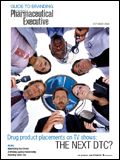Introduction: Evolutionary Branding
A DTC backlash is forcing branders to come up with new marketing approaches. Some are better than others ... much better
Between Congress, the courts, and consumers, it has been a rocky year for DTC. By summer's end, several pharmaceutical giants had agreed to delay the consumer advertising of new prescription drugs for six months (see "Branding Under Fire").

Marylyn Donahue
Many of the current DTC ads seem lacking in pizzazz (the new Lipitor ad for one). Gone are the iconic images—bumble bees, beavers, and moths—that made the old ads stick in a viewer's mind. A subtler breed of marketing that skirts regulations altogether is emerging. One approach is not to name the brand at all—Pfizer's Chantix ad that aired during the Olympics was about quitting smoking. Merck's Gardasil campaign hawks Char4life bracelets. And a rooster for Sanofi Aventis' Ambien involves 15 seconds of a crowing rooster that urges the viewer to silenceyourrooster.com. The goal is to get customers to the brand's Web site—proven to be the most successful form of online marketing (the rooster got 400,000 Web site hits in the first seven days it aired).
By far the most subtle, even stealth-like, marketing approach is to pay to have your brand mentioned on a TV show (see "Detailing Dr. House: Promotion or Risky Prescribing?").
For less covert and more strategic marketing tactics, we asked the heads of the top independent advertising agencies to share their ideas (see "Branding Under Fire"). They saw the moratorium as an opportunity to educate doctors and to create deeper more direct dialogues between brands and consumers. "We should give physicians, patients, and consumers credit that they can discuss the issues, think for themselves, and make appropriate choices," said Al Topin, sounding like a breath of fresh air.
Marylyn Donahue is Pharmaceutical Executive's special projects editor. She can be reached at mdonahue@advanstar.com

The Misinformation Maze: Navigating Public Health in the Digital Age
March 11th 2025Jennifer Butler, chief commercial officer of Pleio, discusses misinformation's threat to public health, where patients are turning for trustworthy health information, the industry's pivot to peer-to-patient strategies to educate patients, and more.
Navigating Distrust: Pharma in the Age of Social Media
February 18th 2025Ian Baer, Founder and CEO of Sooth, discusses how the growing distrust in social media will impact industry marketing strategies and the relationships between pharmaceutical companies and the patients they aim to serve. He also explains dark social, how to combat misinformation, closing the trust gap, and more.